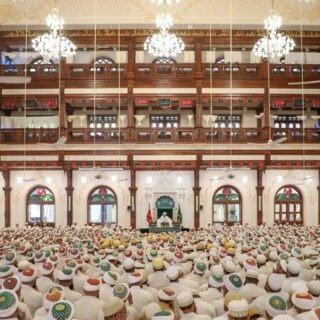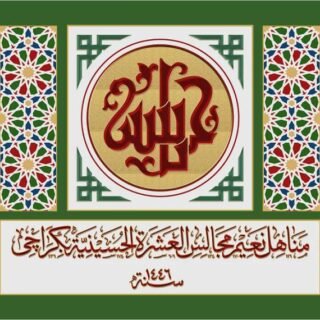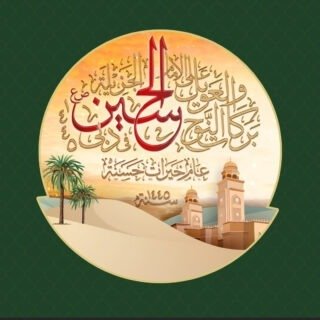This chapter reveals the depth and all-inclusiveness of the ´ilm of Aale MohammedAS. It makes us realize the misleading compartmentalization of knowledge between supposedly religious and secular. Al-´ilm is one and it is this understanding, given to us by the Ikhwaan al-Safaa’: Duat Mutlaqeen, which enables us to acquire knowledge and apply it for the betterment of both the spiritual and temporal realms.
At the onset, Moulana al-Imam Ahmed al-MasturAS explains that the purpose of this chapter is to help seekers of knowledge attain their goal and guide them in fulfilling their aspirations. The intentions with which one seeks knowledge differ from one individual to another, just as physical preferences for different types of cuisine, colours and fragrances differ.
He states, “Know my brother, that the types of knowledge which man can comprehend are three: Propaedeutic Sciences, Religious Sciences and Philosophical and True Sciences.
There are nine Propaedeutic Sciences, which pertain to education. The majority of these have been laid down to facilitate the seeking of one’s livelihood and for the betterment of his temporal life. They are:
- Writing and reading
- Linguistics and grammar
- Accounts and dealings
- Poetry and prosody
- Augur [from the flight of birds] and omens
- Charms, incantation of Quranic verses, alchemy and mechanics
- Profession and craft
- Sales, purchasing, trade, agriculture and animal husbandry
- Biographies and history
The Religious Sciences which have been laid down for curing the soul and for the quest of the hereafter are of six types:
- Revelation
- Interpretation
- Narratives and accounts
- Jurisprudence, customs and rules
- Remembrance, admonition, zohd and mysticism
- Interpretation of dreams
The learned in the field of revelation are those who recite and memorize the Quran. The learned in interpretation are the Aimmat TahereenAS, the successors of the prophets. The learned in the field of narration are the Scholars of Tradition. The learned in the field of law and customs are the Jurists. The learned in the realms of remembrance and admonition are the Worshippers, those who practice zohd, Ascetics and others similar to them. Those learned in the subject of interpreting dreams are the Interpreters.
There are four types of Philosophical knowledge:
- Propaedeutic
- Logic
- Natural Sciences
- Metaphysics
The first of the propaedeutic knowledge is mathematics. It consists of understanding the essence of numbers, their various types and the unique qualities of each. It also explains how all numbers ascend from the number 1, which is before the number 2, and the various meanings that are revealed when one number is added to another.
The second is engineering which leads to an understanding of lengths and dimensions; their various types, the specialities of each and the meanings that become apparent when one dimension is joined with the other. It shows how these lengths and dimensions all stem from one dot, which is the source of all lines, and in the field of engineering is like the number 1 in numbers.
The third is astronomy, which seeks to understand the number, the dimensions and the measurements of the celestial spheres, stars and constellations. It deals with their composition, the speed with which they move, how they rotate, the essence of their nature and how they foretell events before their occurrence.
The fourth is music, which is the science of combination and synthesis. It imparts an understanding regarding the essence of correlation and harmonization. It teaches us how things which are fundamentally different are brought together. How things which differ in form, contrast in strength and are incompatible in nature come together and synthesize, so that they no longer repel each other. Ultimately, combining, uniting and becoming one. They may then carry out one or many acts. Imam states that in each of these fields we have composed an epistle which serves as an introduction.
The second type of philosophical knowledge, Logic, is further divided into five types:
- Poetics
- Rhetoric (art of persuasion)
- Topics (art of dialectic)
- Analytics
- Sophistical Refutations
Past and present scholars have discussed these fields of knowledge and have authored a great number of books, which are present today. Aristotle authored three other texts, which serve as an introduction to his Kitaab al-Burhaan (Posterior Analytics): Categories, On Interpretation and Prior Analytics. He devoted a significant portion of his efforts towards Kitaab al-Burhaan since analytics are the measure of the erudite, through which they identify and distinguish truth from falsehood, right perspectives from wrong ones, the belief of Haqq from that of falsehood and good deeds from bad ones. In the manner in which people use scales and measures to find the weight and dimensions of things over which estimates and assessments differ, scholars well-versed in analytics employ it to determine the truth in matters where opinions and views differ. For example those learned in poetry can determine the soundness of a poem though their knowledge of prosody.
Porphyry of Tyre wrote the book Isagoge as an introduction to the art of scholastic logic. However, due to people who were heedless of its meanings commenting on it extensively and translating it from one language to another, the understanding of the concepts and meanings entailed in it were lost on all those who referred to it.
In each of these arts we have composed an epistle that covers the necessary points, and have done away with verbosity. However, at this juncture we wish to discuss the purpose behind each epistle, so that whoever refers to them is aware of the objectives of each field prior to delving into it:
- Isagoge offers an understanding of the six terms that philosophers use in their discourse: Definition, Species, Genus, Differentia, Property and Accident.
- Categories helps comprehend the significance and utility of ten categories (praedicamenta), and how they uncover the meanings entailed in each and every object of human apprehension.
- On Interpretation provides a further understanding of the 10 terms in Categories and how they lead to basic linguistic forms which then entail either truth or falsehood.
- Prior Analytics imparts a further understanding of these 10 terms and how they form the basis for various propositions. It explains their various types and how they are used to make deductions.
- Posterior Analytics dwells upon the use of syllogism of Haq and the correct Burhan in which there is no room for error.
The third realm of philosophical knowledge, Natural Sciences is further divided into seven streams.
- Science of Corporal Principles, which pertains to an understanding of five things: primordial matter, form, time, space and motion; and the meanings that result when they combine with each other.
- Science of the Sky and the World, which leads to a comprehension of the essence of the planets, stars and their orbits. It deals with their numbers and composition, why they revolve and whether they are subject to coming into being and decomposing in the way the Four Elements beneath the moon’s orbit are. It explores the reasons behind the motion of the planets and their different speeds, the motion of the celestial orbits and why the earth, in the middle of the sky, in the centre, is stationary. It answers whether any entity exists beyond this universe and whether there are places in this universe where no matter exists, as well as other similar discussions.
- Science of the World of Coming into Being and Decomposition, which concerns itself with understanding the essence of the Four Elements: Fire, Air, Water and Earth. It explains how they transform into one other through the influence of divine bodies, how these elements come together to form various minerals, plants and animals and how they revert to their original form once these organisms and beings cease to exist.
- Science of Atmospheric Occurrences, which deals with changes in the atmosphere due to the influence of planets, by their motion and by their rays falling upon these elements and acting upon them. Especially, air for it is prone to changes such as light, darkness, heat, cold, currents, fog, clouds, rain, snow, hail, lightning, thunder, shooting stars, thunderbolts, comets, rainbows, whirlwinds, halos, and other similar changes and occurrences which take place above us.
- Science of Minerals, which pertains to understanding the minerals and stones that are formed by vapours confined inside the Earth and fine dust particles in the atmosphere, in caves, in the depths of the seas: medicines, stones, sulphur, mercury, alum, salts, ammonia, gold, silver, copper, iron, lead, graphite, galena, arsenic, crystal, ruby, bezoar and other similar substances. It studies their specialities, benefits and ill-effects.
- Science of Plants, which focuses on learning about the vegetation that grows or sprouts upon the face of the earth, on mountaintops, in the depths of the seas and on the banks of rivers. It concerns itself with trees, crops, vegetables, herbs and legumes, weeds, grass and herbage. It leads to an understanding of the various species of plants, their properties, growth location, how their roots spread beneath the earth and how their branches and stems rise towards the air. It shows how these plants spread across the earth, their branches extend in all directions, the shapes of their branches: some long, some short; some thin some thick; some soft, some rough. And the colours and hues of their flowers, the shape of their fruits, grains, seeds, gums; their taste and smell; their specialities, benefits and ill-effects — of each of them.
- Science of Animals, which pertains to the understanding of each organism that possesses the capacity to eat, grow, sense and move, be it those walking on the face of the earth or flying in the sky or swimming in water or crawling on sand or moving about inside the body of another organism, like worms inside animals and in the pulp of plants and fruits. It allows us to ascertain the number of genus and the species in each, as well as the specialities of each. It shows us how these organisms are created in wombs or in eggs or in filth. It shows how their limbs and organs come together; how their bodies are composed, why their forms differ, how they reproduce, their varying sounds, their repulsive natures, diverse characters and homogeneous actions. It leads to an understanding of their mating season and habits, their habitats, their kindness in nurturing their offspring, the affection shown to their younglings and how they teach them what benefits them and what is detrimental to them: their habitats, their leaders and their enemies and other such aspects.
Contemplating and discussing the above is all a part of the Natural Sciences. Similarly, medicine, veterinary medicine, training livestock, wild animals and birds, agriculture and animal husbandry, and craftsmanship are all part of the Natural Sciences.








